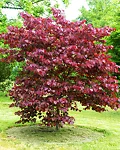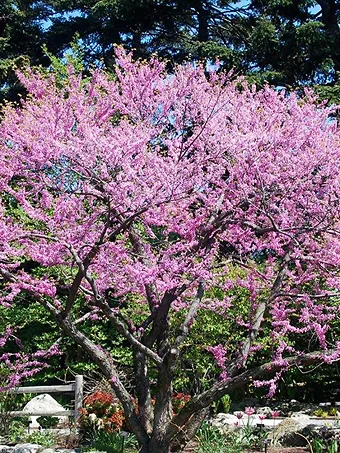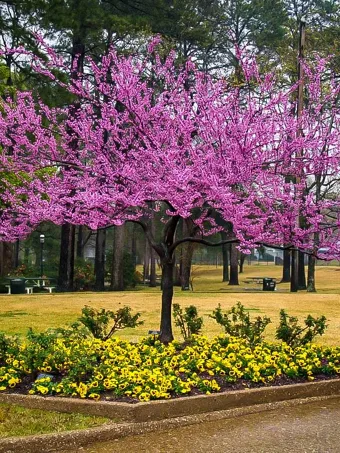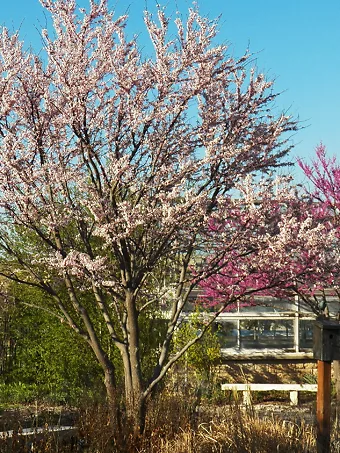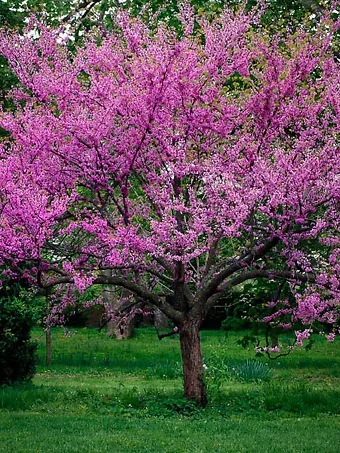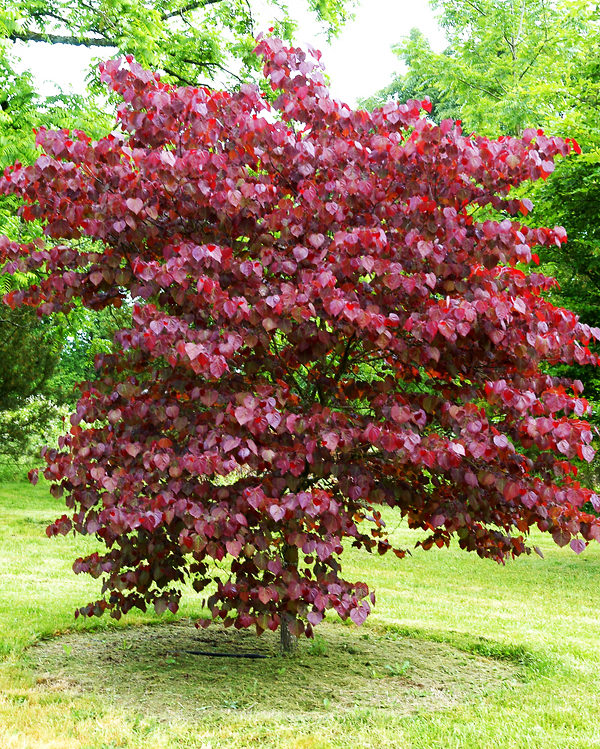
Merlot Redbud Tree
Cercis canadensis 'Merlot' (PP# 22,297)View more from Redbud Trees
Merlot Redbud Tree
Cercis canadensis 'Merlot' (PP# 22,297)
30 day - ARRIVE AND THRIVE™ guaranteeLearn more


Special Features

Botanical Name
Cercis canadensis 'Merlot' (PP# 22,297)
Outdoor Growing zone
6-9
Mature Height
12-15
Mature Width
12-15
Sun needs
Full Sun, Partial Sun
The Merlot Redbud is a new, heat-resistant redbud with striking red-purple early foliage, turning burgundy by summer. The flowers appear on the bare branches in April, and they are a powerful and effective lavender purple color. This small tree grows 18 inches a year, quickly developing into a graceful multi-stemmed plant reaching 12 to 15 feet tall and wide. The foliage is unusually leathery and glossy, which, with its unique breeding, makes this plant especially suitable for warmer zones, coping with more sun and dryness, than most other redbud trees available. This tree is beautiful and worthy of being grown everywhere it will.
- Bare spring branches covered in lavender-pink blooms
- Powerful red-purple to burgundy foliage in spring and summer
- More resistant to heat and drought than other redbuds
- Trouble-free and fast-growing
- Dark branches make a striking winter silhouette
Plant the Merlot Redbud in full sun or partial shade, in ordinary to moist, well-drained garden soil. It is hardy in zones 6 to 9. Pests and diseases normally don’t trouble it, and deer ignore it. It doesn’t suffer from the sunburn and leaf shriveling sometimes seen on redbuds grown in sunny and dry places in hot zones. No pruning is needed, and this tree will quickly develop into a beautiful addition to your garden.

Redbuds are wonderful native shrubs that flower in early spring, on bare branches. While beautiful in bloom, there is a long period when they are just green – until several purple-leaf forms were developed. Although basically easy to grow, this shrub can be a little more tricky in warmer, drier areas, and suffer scorch and burning in the summer. There is a southern form, from Texas, so plant breeders took that plant’s drought-resistance and bred it with forms with the best colors. The result? The Merlot Redbud, which combines dark-pink blooms with rich purple leaves and puts them onto a drought and heat-resistant plant that gardeners in hotter states will love. Even if you live in cooler areas, the heady mix of rich blooms and purple foliage is as potent as the wine the Merlot Redbud is named for.
The Merlot Redbud is a deciduous shrub or small tree, with an upright, broad form, growing 12 to 15 feet tall, and just as wide. It has a multi-stem trunk, with striking near-black bark and a fine tracery of branches that give it an intriguing winter profile. This plant is vigorous and fast-growing, adding 18 inches of length to its main stems every year, so it doesn’t take long before you are gazing on a good-sized bush in your garden.
In late March to the middle of April, depending on your growing zone, when most other plants are still dormant, the Merlot Redbud bursts into bloom. The flowers are small, but they sprout in clusters not just on the stems of the previous year, but all along the older limbs as well, creating an incredibly dense flowering, with a unique look, because the flowers sit directly on the branches, without stalks. Young plants bloom well, and the flowers may be small – just ½ inch long – but their abundance, and their vibrant, bright lavender-pink color, shouts out all across the garden, through the still-bare branches of other bushes. The flowers look like tiny sweet peas, telling us that this shrub, unexpectedly, is in the pea family.
Flowering lasts 2 or 3 weeks, and as the flowers fade the leaves emerge. When young they are a rich, deep purple-red. Gradually they mature to glowing burgundy, and then as summer settles in they turn dark green. They are unusually glossy, leathery and small, part of the special ability of this plant to resist dryness.
Grow the Merlot Redbud as a feature shrub in a bed, or on a lawn. Grow it as an accent plant, using the foliage color to maximum effect. Use it along the edges of woodlands, which is like its natural habitat, underneath larger deciduous trees. It is very effective edging ponds and streams or growing down a sloping bank.
The Merlot Redbud is hardy from zone 6 to zone 9. Because of its breeding it is less suitable for zone 5 than other redbuds, such as the Cotton Candy Redbud, or the purple-leafed ‘Forest Pansy’. However, that breeding makes it more suitable for hotter zones, and areas with hot, dry summers. Choose the varieties that suit your region best. It grows well in most well-drained soil, with no particular preference for acidic or alkaline soils. It thrives in full sun – better than more northern forms – but it also loves to grow in partial shade, perhaps with morning sun and then protected by the dappled shade of other trees in the afternoon. It has no pests or diseases of concern, and deer usually ignore it. It also doesn’t produce the brown seed pods of most other varieties, so there is less litter with this variety. Pruning is not needed, although you can remove some crowded branches from the center as it grows, to create a more attractive open profile.
The Merlot Redbud was created in an extended breeding program by Dennis Werner and Karlton Snelling, from Raleigh, North Carolina. The eastern redbud, Cercis canadensis has a variety that grows in Texas that is considerably more resistant to heat and drought than the northern forms. In 1998 the breeders took pollen from a northern form with purple leaves called ‘Forest Pansy’ and pollinated a white-flowered form of Cercis canadensis var. texensis, called ‘Texas White’. They grew 113 seedlings in an isolated field, and in 2002 collected seed from all those that flowered that spring. About 100 seedlings were grown from that seed, and 4 were found with purple leaves. These were further grown, and one was selected in 2004. Initially called NC2004-6, it was selected for its purple leaves, lavender flowers and semi-upright form. This plant was named ‘Merlot’ and patented in 2011. Since then it has been acclaimed for its beauty, and for its heat and drought resistance too, compared to most other forms of this plant. You can see the work and patience that went into creating this unique and beautiful plant. We have been able to find a small number of grafted plants grown from that original. The demand is huge for quality redbud trees, so these plants will soon be gone – order now.
